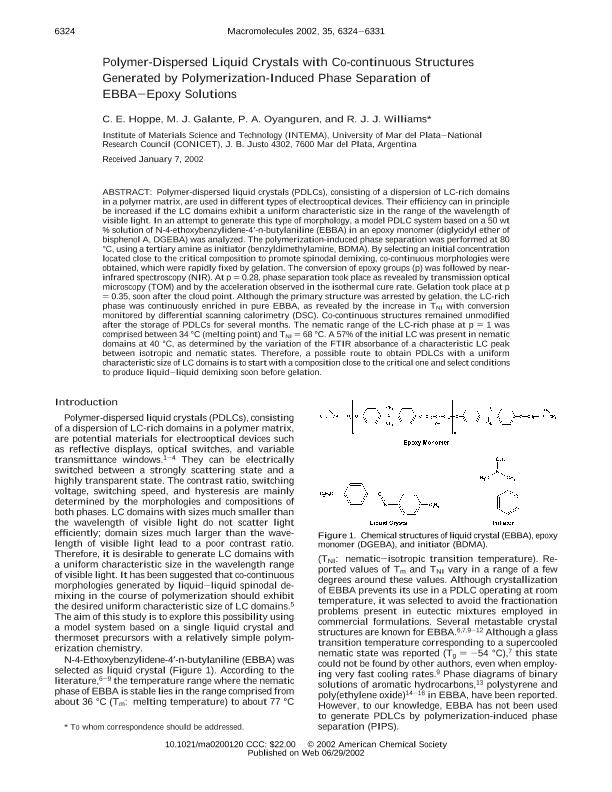Mostrar el registro sencillo del ítem
dc.contributor.author
Hoppe, Cristina Elena

dc.contributor.author
Galante, Maria Jose

dc.contributor.author
Oyanguren, Patricia Angelica

dc.contributor.author
Williams, Roberto Juan Jose

dc.date.available
2019-06-13T16:34:17Z
dc.date.issued
2002-07
dc.identifier.citation
Hoppe, Cristina Elena; Galante, Maria Jose; Oyanguren, Patricia Angelica; Williams, Roberto Juan Jose; Polymer-Dispersed Liquid Crystals with Co-continuous Structures Generated by Polymerization-Induced Phase Separation of EBBA-Epoxy Solutions; American Chemical Society; Macromolecules; 35; 16; 7-2002; 6324-6331
dc.identifier.issn
0024-9297
dc.identifier.uri
http://hdl.handle.net/11336/78219
dc.description.abstract
Polymer-dispersed liquid crystals (PDLCs), consisting of a dispersion of LC-rich domains in a polymer matrix, are used in different types of electrooptical devices. Their efficiency can in principle be increased if the LC domains exhibit a uniform characteristic size in the range of the wavelength of visible light. In an attempt to generate this type of morphology, a model PDLC system based on a 50 wt % solution of N-4-ethoxybenzylidene-4‘-n-butylaniline (EBBA) in an epoxy monomer (diglycidyl ether of bisphenol A, DGEBA) was analyzed. The polymerization-induced phase separation was performed at 80 °C, using a tertiary amine as initiator (benzyldimethylamine, BDMA). By selecting an initial concentration located close to the critical composition to promote spinodal demixing, co-continuous morphologies were obtained, which were rapidly fixed by gelation. The conversion of epoxy groups (p) was followed by near-infrared spectroscopy (NIR). At p = 0.28, phase separation took place as revealed by transmission optical microscopy (TOM) and by the acceleration observed in the isothermal cure rate. Gelation took place at p = 0.35, soon after the cloud point. Although the primary structure was arrested by gelation, the LC-rich phase was continuously enriched in pure EBBA, as revealed by the increase in TNI with conversion monitored by differential scanning calorimetry (DSC). Co-continuous structures remained unmodified after the storage of PDLCs for several months. The nematic range of the LC-rich phase at p = 1 was comprised between 34 °C (melting point) and TNI = 68 °C. A 57% of the initial LC was present in nematic domains at 40 °C, as determined by the variation of the FTIR absorbance of a characteristic LC peak between isotropic and nematic states. Therefore, a possible route to obtain PDLCs with a uniform characteristic size of LC domains is to start with a composition close to the critical one and select conditions to produce liquid−liquid demixing soon before gelation.
dc.format
application/pdf
dc.language.iso
eng
dc.publisher
American Chemical Society

dc.rights
info:eu-repo/semantics/openAccess
dc.rights.uri
https://creativecommons.org/licenses/by-nc-sa/2.5/ar/
dc.subject
Pdlc
dc.subject
Epoxy
dc.subject
Polymerization Induced Phase Separation
dc.subject.classification
Físico-Química, Ciencia de los Polímeros, Electroquímica

dc.subject.classification
Ciencias Químicas

dc.subject.classification
CIENCIAS NATURALES Y EXACTAS

dc.subject.classification
Ingeniería de los Materiales

dc.subject.classification
Ingeniería de los Materiales

dc.subject.classification
INGENIERÍAS Y TECNOLOGÍAS

dc.title
Polymer-Dispersed Liquid Crystals with Co-continuous Structures Generated by Polymerization-Induced Phase Separation of EBBA-Epoxy Solutions
dc.type
info:eu-repo/semantics/article
dc.type
info:ar-repo/semantics/artículo
dc.type
info:eu-repo/semantics/publishedVersion
dc.date.updated
2019-05-15T16:46:04Z
dc.journal.volume
35
dc.journal.number
16
dc.journal.pagination
6324-6331
dc.journal.pais
Estados Unidos

dc.journal.ciudad
Washington
dc.description.fil
Fil: Hoppe, Cristina Elena. Consejo Nacional de Investigaciones Científicas y Técnicas. Centro Científico Tecnológico Conicet - Mar del Plata. Instituto de Investigaciones en Ciencia y Tecnología de Materiales. Universidad Nacional de Mar del Plata. Facultad de Ingeniería. Instituto de Investigaciones en Ciencia y Tecnología de Materiales; Argentina
dc.description.fil
Fil: Galante, Maria Jose. Consejo Nacional de Investigaciones Científicas y Técnicas. Centro Científico Tecnológico Conicet - Mar del Plata. Instituto de Investigaciones en Ciencia y Tecnología de Materiales. Universidad Nacional de Mar del Plata. Facultad de Ingeniería. Instituto de Investigaciones en Ciencia y Tecnología de Materiales; Argentina
dc.description.fil
Fil: Oyanguren, Patricia Angelica. Consejo Nacional de Investigaciones Científicas y Técnicas. Centro Científico Tecnológico Conicet - Mar del Plata. Instituto de Investigaciones en Ciencia y Tecnología de Materiales. Universidad Nacional de Mar del Plata. Facultad de Ingeniería. Instituto de Investigaciones en Ciencia y Tecnología de Materiales; Argentina
dc.description.fil
Fil: Williams, Roberto Juan Jose. Consejo Nacional de Investigaciones Científicas y Técnicas. Centro Científico Tecnológico Conicet - Mar del Plata. Instituto de Investigaciones en Ciencia y Tecnología de Materiales. Universidad Nacional de Mar del Plata. Facultad de Ingeniería. Instituto de Investigaciones en Ciencia y Tecnología de Materiales; Argentina
dc.journal.title
Macromolecules

dc.relation.alternativeid
info:eu-repo/semantics/altIdentifier/url/https://pubs.acs.org/doi/abs/10.1021/ma0200120
dc.relation.alternativeid
info:eu-repo/semantics/altIdentifier/doi/http://dx.doi.org/10.1021/ma0200120
Archivos asociados
